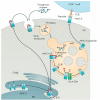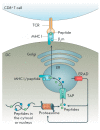Molecular and Cellular Mechanisms of Antitumor Immune Response Activation by Dendritic Cells
- PMID: 27795841
- PMCID: PMC5081705
Molecular and Cellular Mechanisms of Antitumor Immune Response Activation by Dendritic Cells
Abstract
Dendritic cells (DCs) play a crucial role in the initiation and regulation of the antitumor immune response. Already , DC-based antitumor vaccines have been thoroughly explored both in animal tumor models and in clinical trials. DC-based vaccines are commonly produced from DC progenitors isolated from peripheral blood or bone marrow by culturing in the presence of cytokines, followed by loading the DCs with tumor-specific antigens, such as DNA, RNA, viral vectors, or a tumor cell lysate. However, the efficacy of DC-based vaccines remains low. Undoubtedly, a deeper understanding of the molecular mechanisms by which DCs function would allow us to enhance the antitumor efficacy of DC-based vaccines in clinical applications. This review describes the origin and major subsets of mouse and human DCs, as well as the differences between them. The cellular mechanisms of presentation and cross-presentation of exogenous antigens by DCs to T cells are described. We discuss intracellular antigen processing in DCs, cross-dressing, and the acquisition of the antigen cross-presentation function. A particular section in the review describes the mechanisms of tumor escape from immune surveillance through the suppression of DCs functions.
Keywords: antigen presentation and cross-presentation; dendritic cells; proteasome; subsets; tumor immunosuppression.
Figures






Similar articles
-
In Vitro Generation of Human XCR1(+) Dendritic Cells from CD34(+) Hematopoietic Progenitors.Methods Mol Biol. 2016;1423:19-37. doi: 10.1007/978-1-4939-3606-9_2. Methods Mol Biol. 2016. PMID: 27142006
-
Outer membrane vesicles engineered to express membrane-bound antigen program dendritic cells for cross-presentation to CD8+ T cells.Acta Biomater. 2019 Jun;91:248-257. doi: 10.1016/j.actbio.2019.04.033. Epub 2019 Apr 17. Acta Biomater. 2019. PMID: 31003032
-
Tumor cell lysate-pulsed human dendritic cells induce a T-cell response against pancreatic carcinoma cells: an in vitro model for the assessment of tumor vaccines.Cancer Res. 2001 Sep 1;61(17):6445-50. Cancer Res. 2001. PMID: 11522639
-
Acquisition and Presentation of Tumor Antigens by Dendritic Cells.Crit Rev Immunol. 2015;35(5):349-64. doi: 10.1615/critrevimmunol.v35.i5.10. Crit Rev Immunol. 2015. PMID: 26853848 Review.
-
Dendritic cell biology and its role in tumor immunotherapy.J Hematol Oncol. 2020 Aug 3;13(1):107. doi: 10.1186/s13045-020-00939-6. J Hematol Oncol. 2020. PMID: 32746880 Free PMC article. Review.
Cited by
-
The EXTREME Regimen Associating Cetuximab and Cisplatin Favors Head and Neck Cancer Cell Death and Immunogenicity with the Induction of an Anti-Cancer Immune Response.Cells. 2022 Sep 14;11(18):2866. doi: 10.3390/cells11182866. Cells. 2022. PMID: 36139440 Free PMC article.
-
Myeloid and Plasmacytoid Dendritic Cells and Cancer - New Insights.Open Access Maced J Med Sci. 2019 Oct 13;7(19):3324-3340. doi: 10.3889/oamjms.2019.735. eCollection 2019 Oct 15. Open Access Maced J Med Sci. 2019. PMID: 31949539 Free PMC article. Review.
-
Immunomodulatory Properties of Masticadienonic Acid and 3α-Hydroxy Masticadienoic Acid in Dendritic Cells.Molecules. 2022 Feb 21;27(4):1451. doi: 10.3390/molecules27041451. Molecules. 2022. PMID: 35209237 Free PMC article.
-
Growth Inhibition of Retinoblastoma Cell Line by Exosome-Mediated Transfer of miR-142-3p.Cancer Manag Res. 2022 Jun 29;14:2119-2131. doi: 10.2147/CMAR.S351979. eCollection 2022. Cancer Manag Res. 2022. PMID: 35791342 Free PMC article.
-
Cetuximab and IL-15 Promote NK and Dendritic Cell Activation In Vitro in Triple Negative Breast Cancer.Cells. 2020 Jun 28;9(7):1573. doi: 10.3390/cells9071573. Cells. 2020. PMID: 32605193 Free PMC article.
References
-
- Greenberg S., Grinstein S.. Curr. Opin. Immunol. 2002;14:136–145. - PubMed
-
- Yarilin A.A. The basics of immunology. M.: Medicine, 1999. 1999. The basics of immunology; p. 608.
-
- Figdor C.G., van Kooyk Y., Adema G.J.. Nat. Rev. Immunol. 2002;2:77–84. - PubMed
-
- Fong L., Engleman E.G.. Annu. Rev. Immunol. 2000;18:245–273. - PubMed
LinkOut - more resources
Full Text Sources
Other Literature Sources
